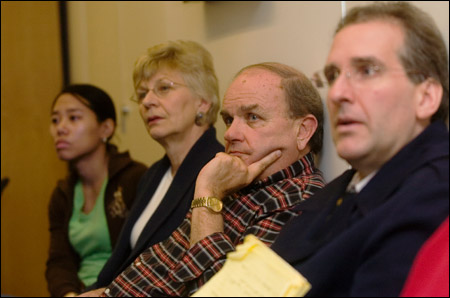Canada and U.S. grow apart
Surveys show acceleration toward very different world views
If the relationship between Canadians and Americans were put into lyrics, an appropriate song might go: “Canadians say potato, Americans say potahto.”
After all, the two nations speak the same language, albeit with different accents. They also share the world’s longest unfortified border and are so similar in other ways that some say they’re nearly indistinguishable to the rest of the world.
But a Canadian researcher examining attitudes of the two nations’ citizens says that despite our similarities, our core values are different and diverging more rapidly since the 9/11 terrorist attacks.

Michael Adams, a survey researcher and author of the Canadian best-seller “Fire and Ice: The United States, Canada and the Myth of Converging Values,” painted a statistical picture of the two nations Monday (Nov. 27) during a talk at the Center for Government and International Studies.
The event, “Fire and Ice: Are Canada and the U.S. Coming Together or Coming Apart?,” was part of the Weatherhead Center for International Affairs’ Canada Seminar, hosted by Richard Simeon, the William Lyon MacKenzie King Visiting Professor of Canadian Studies. Simeon, a professor of political science at the University of Toronto, serves as seminar series’ chair.
Adams, a best-selling author in Canada, is president of Environics Research Group Ltd., a marketing and social research firm that has been conducting in-depth surveys of both Canadian and American attitudes during U.S. presidential election years since 1992.
Though his core presentation focused on values, Adams established the framework of differences between the two nations by examining Canadian attitudes toward the United States in recent decades.
And it’s not pretty.
When asked which nation presents the greatest threat to world peace, 40 percent of Canadians said the United States is a global threat, with Iraq a distant second at 15 percent.
The U.S.’s favorability ratings in Canada are also taking a hit. For the 20 years from 1981 to 2001, roughly three-quarters of Canadians had a favorable view of the United States. But in the five years from 2001 to 2006, those numbers nosedived, to 49 percent, while those who viewed the United States unfavorably rose from less than 20 percent to the same number.
“This is a remarkable change. This is a remarkable achievement … or whatever,” Adams said.
An examination of the underlying values of the two nations reveals changes that may illuminate those growing differences.
Adams’ research shows U.S. citizens growing more conservative and security-minded, while Canadians are headed in the other direction, growing more welcoming to newcomers, more accommodating of differences, and less trustful in the machinery of government.
Using family structure as an indicator of attitudes toward core institutions, Adams said responses to the statement “The father must be the master in his own house” is revealing.
While the percentage of Canadians who agree with the statement declined slightly between 1992 and 2004, from 26 percent to 21 percent, the percentage of people in the United States agreeing, larger to start with, increased from 42 percent to 52 percent.
“This certainly is a remarkable difference between two countries on the structure of an important institution in our lives, our families,” Adams said.
On measures of character, Adams said his surveys show U.S. citizens moving from a nation, on average, of soccer moms and Little League dads – people who played by the rules and won – in 1992, toward a state of “exclusion and identity” marked by xenophobia, risk-taking, and everyday rage.
Canadians, on the other hand, are becoming more, well, Canadian. They were characterized, on average, by what Adams termed “idealism and autonomy” in 1992, marked by tolerance and individuality, and more deeply embraced those characteristics by 2004.
Adams said his overall picture of Americans versus Canadians shows that people in the United States are more religious, work more, are more confident, but need more order in their daily lives, probably because they’re so pressed for time, Adams said.
Americans are also more sexist, less tolerant of nontraditional families, more conscious of and accepting of violence, and more concerned about style and outward appearances, according to Adams. The poor in Canada are better off than those in the United States, but the Canadian wealthy are worse off than their peers down south.
“It’s still pretty cool to be rich in America,” Adams said.




